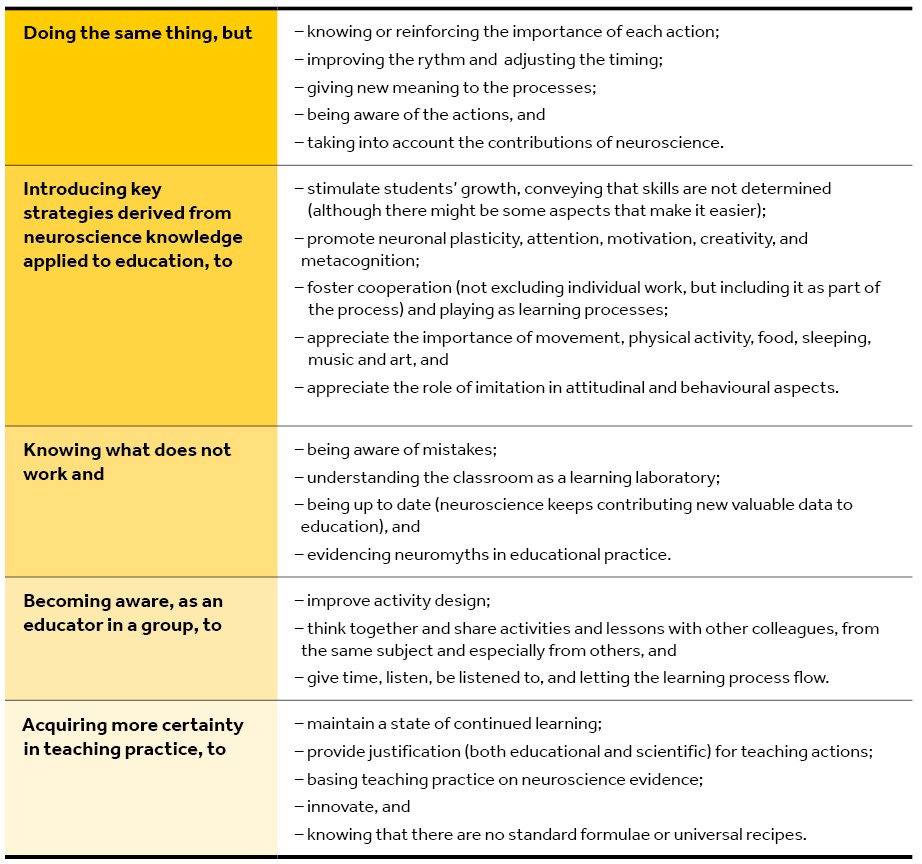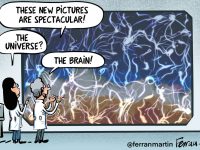Can neuroscience be applied to education?
Understanding learning processes in the brain

According to some scientific and political managers, the twenty-first century is the century of neuroscience. Whether it is true or not (because physicists say it too regarding quantum applications, as do computer scientists regarding artificial intelligence, among other groups in the scientific-technological environment), the fact is that neuroscience is in fashion. Not surprisingly, given the great advances in recent years in the understanding of the formation and functioning of the human brain, and its relationship with intellectual life, behaviour, and cognition. And now a simple Internet search finds more than 70 million entries with words beginning with the prefix neuro- in less than a second.
«The use of the neuro- prefix gives a patina of science to fields that use different working methodologies to that used in neuroscientific research»
Neologisms such as neuroeducation, neurodidactics, neuropedagogy, neuroethics, neuroreligion, neuropsychology, neuromodality, neuroart, neuroarchitecture, neuroeconomics, neuropolitics, neurosales, neurocoaching, neurolinguistics, neuromarketing, neurosecurity, neuroleadership, etc., are becoming more and more common. The use of this prefix gives a patina of science to fields that, despite being very established within academia, use different, or slightly different, working methodologies to the scientific method used in neuroscientific research. One example is education. Can the application of neuroscience to education be studied while maintaining every aspect of the scientific method used in neuroscience? Or, even more simply, can neuroscience be applied to education?
Neuroscience is an experimental science
Consider, for a moment and just as an example, another neuro- neologism that I have not included in the previous list. Neuromorality is an emerging field of neuroscience whose objective is to study the relationships between morality and the functioning of the brain. One of its foundational works, for example, identified the involvement of the prefrontal cortex in moral decisions (Greene, Nystrom, Engell, Darley, & Cohen, 2004). Even so, morality is itself a field of knowledge that determines the rectitude of human behaviour according to cultural and social norms that express the existence of duties and obligations, and that can be analysed from many perspectives – sociological, philosophical and religious – each with its own methods, but not using the scientific method as in neuroscience.
In other words, the rectitude of human behaviour is subjective. It depends on different and changing cultural and social norms, while the distinctive feature of science is its unwavering commitment to objectivity. In neuromorality, neuroscience makes it possible to identify the relationships between the brain and moral decisions, for example, by analysing which brain areas or neural circuits are involved in them using neuroimaging techniques (see Redolar, 2014, for a description of the most commonly used neuroimaging techniques), but in no case does it make it possible to determine which is the best moral option in a given circumstance.

Designed by Freepik
Neuroscience is the scientific discipline that studies every aspect of the nervous system; i.e., its molecular, cellular, anatomical, and functional structure; the embryonic and fetal development and the changes that take place in the course of life; the evolution of the nervous system from the origin of the metazoans to our current species; the pathologies that can affect it and the therapies and pharmacology to treat them, and also the interaction of all these elements to generate the human mind, understood as an emergent property of the brain’s functioning. In other words, the brain as the biological basis of cognition and behaviour. As previously stated, neuroscience is an experimental scientific discipline, and as such its advancement is strictly subject to the scientific method. For a description of the main methods of study in experimental neuroscience, see Harrington (2020). And for a useful and simple description to check whether a proposal minimally follows the scientific method, I recommend La ciencia en 4D (Purroy, 2015), which proposes a simple approach to detect whether a proposal has a scientific basis through the presence of four aspects beginning with the letter D: data, debate, discard, and disseminate. If any of them is missing, it is not science, as is the case with a significant number of neuro- proposals one can find on the Internet.
«The brain is the organ of thought, from which all mental and cognitive abilities arise and are managed, including the ability to learn»
Let us circle back to the brain. It is the organ of thought, from which all mental and cognitive abilities arise and are managed, including the ability to learn. In fact, as a biological species, one of our most important survival adaptations is actually the ability to learn. We learn by instinct, and this instinct compels us to acquire knowledge of our environment, especially – but not only – of our social environment, with a specific purpose: to be able to anticipate changes. We live in a dynamic and changing, yet uncertain, environment. Being able to anticipate both threats and opportunities increases the probability of survival, by avoiding them or taking advantage of them, respectively.
Learning is instinctive, as several works have shown. For example, it has been observed that children in the preverbal stage spontaneously use philosophical reasoning such as disjunctive syllogism (Mody & Carey, 2016) and the scientific method (Cook, Goodman, & Schulz, 2011) to acquire knowledge and anticipate situations. Even so, this does not mean that it is not interesting – even important or crucial – to favor certain types of learning, not only what is learned, but in a very special way how it is learned. It is here that neuroscience and education come into contact in a synergistic way. On the one hand, the functional and anatomical aspects of the brain allow us to acquire new knowledge. On the other hand, learning alters our brain’s connectivity through neuronal (or synaptic) plasticity, which allows us to store this knowledge in our memory. And finally, mental life arises from the activity of the brain, from the patterns of neuronal connections. In other words, learning conditions mental life through the organ managing these two processes. This is where education comes into play.
Education uses the scientific method, but it has certain limitations
The first writings and treatises on education, through pedagogy and didactics, date back to classical Greece. Since then, very diverse proposals have emerged in different cultures and social contexts (for a summary of some of these proposals, see Bueno, 2019). Around 350 BCE, for example, Aristotle established an educational design based on five periods. Much more recently, from the end of the nineteenth century, several theories have focused on specific aspects of learning, such as behaviourism, focusing on aspects related to observable behaviour; cognitivism, addressing unobservable cognitive processes; constructivist or socio-cultural models, analysing the influence of society and culture; and connectivism, taking into account the role of new technologies and social networks in learning, among others.

Designed by Freepik
The basis of educational research is also the scientific method, but it presents some particularities or limitations (for a description of methods in educational research, see Pérez-Juste, Galán González, & Quintanal Díaz, 2012; for a basic description of the particularities of educational research with respect to the experimental scientific method, see Bueno, 2019; Ruiz, 2020). We must keep in mind that the scientific method uses not only experimental approaches, but also correlational ones, cause-effect comparisons, observational and historical models, sociological surveys, etc. As for the particularities or limitations, the first and most important is that it involves human beings, and more specifically children and adolescents, which increases the complexity of any study. On the one hand, for ethical reasons, it is not possible to carry out certain studies, specifically those that could be detrimental to their cognitive or emotional development. This is especially relevant when establishing control groups, and when trying to demonstrate the negative effects of certain pedagogical interventions. In these cases, the only ethically viable possibility is to carry out correlation studies, identifying people who, for reasons unrelated to the research itself, have been subjected to certain educational processes.
Moreover, the great diversity of socio-cultural, economic, and environmental contexts makes it difficult to generalise from specific studies limited to a particular type of student body. It is also usually difficult to establish which educational parameters or cognitive or emotional successes are evaluated, and by means of which tests or trials, always considering that each teacher is perceived differently by the students, and that, therefore, the mere presence of one teacher or another can slightly modify the results or their interpretation. In this sense, it is often necessary to make assessments indirectly, so that the process itself does not interfere with the cognitive or socio-emotional abilities on which one wishes to act.

Designed by Freepik
To this end, any research in education needs to clearly establish its objectives, the pedagogical interventions to be carried out, the cognitive and socio-emotional parameters to be evaluated, and how this evaluation will be carried out, consistently with the selected control groups. In this sense, one of the usual problems is to have a sufficiently large sample of students to apply statistical tests that provide mathematically sound results. That is why it is important to define the scope of the study and its potential generalisation, to keep conclusions always within the basic essential parameters of the scientific method.
Neuroeducation as the synergy between neuroscience and education
The synergistic application of neuroscience knowledge to the field of education has generated a new academic discipline, neuroeducation. It can be briefly defined as the transdisciplinary field of knowledge and research that promotes the integration of educational sciences with those that deal with the functioning and development of all aspects of neurons and brains; that is, neuroscience. Great ideas are emerging from this interaction, many of which reinforce what modern pedagogy has been postulating for decades, such as the importance of playing and emotions, the need for movement and sensoriality, the importance of collaborative work and social involvement, etc. And also new ones, such as the potential effect of moderate and very well administered doses of stress on attention, the role of surprise and motivation, the value of effort when satisfied on feelings of reward, the relationship between motivation and optimism at the neurotransmitter level, etc.
«Neuroeducation takes into account knowledge about the functioning of the brain, such as attention and memory, or the neurobiological basis of behaviour and emotions»
Within the field of neuroscience, neuroeducation takes into account knowledge about the functioning of the brain, especially related to the plasticity processes underlying higher cognitive functions, such as attention and memory, or the neurobiological basis of behaviour and emotions. Regarding education, it mainly focuses on the development of pedagogical theories and practices that explain how the teaching and learning processes work with different classroom methodologies, didactics, materials, basic competences or teaching skills, among others. It also includes elements from the field of psychology, like concepts and theories about the functioning of cognition and human behaviour, and from sociology, like social interaction factors.
«Neuroeducation is beginning to project a very promising scenario of optimisation and pedagogical evolution, but we must be aware that it still has a long way to go»
At this point we are ready to address the question that lends the title to this article: «Can neuroscience be applied to education?» In other words, can we talk about neuroeducational research? Neuroeducation is still a very young discipline and, at the moment, most available studies are basic research in laboratory contexts. Therefore, there is still a very important lack of research applied to natural learning contexts, and many of the hypotheses and theories are based on correlational research. One of the reasons, besides the young age of this academic discipline, is the limitations discussed in the previous section. Thus, although neuroeducation is beginning to project a very promising scenario of optimisation and pedagogical evolution, we must be aware that it still has a long way to go, and that there are still many «field» experiments to be done (Bueno, 2019; Carballo, 2016; Ruiz, 2020). For this reason, it is understandable that some scientists and pedagogues are sceptical about the real contributions of neuroscience to the design of specific pedagogical practices. It also leads to the appearance of erroneous beliefs, the so-called «neuromyths» (Forés et al., 2015; Howard-Jones, 2014).

Table 1. Effects of knowing how the brain works in the field of education (from Bueno, 2019).
«Neuroeducation is still a very young discipline and most available studies are basic research in laboratory contexts»
In this sense, in the context of neuroscientific research and to reduce the incidence of neuromyths and unscientific or pseudoscientific proposals, Forés and Bueno (2019) proposed to incorporate a fifth D to Purroy’s 4D proposal (2015), the demonstration, meaning that we need to be able to evaluate the results and the process of applying knowledge in neuroscience to the field of education in a dynamic way. Neuroeducation helps us to understand why things work in education, having the functioning of the brain as a base, which makes everything more comprehensible and verifiable (Table 1). As Wagensberg (2006) said in A más cómo, menos por qué, in neuroeducation: «The more we know about why, the less we doubt about how» (Forés & Bueno, 2019). Or, as Jensen (2010) says, «The important thing [in neuroeducation] is [to contribute to] education keeping the brain in mind».
References
Bueno, D. (2019) Neurociencia aplicada a la educación. Madrid: Editorial Síntesis.
Carballo, A. (2016). Neuroeducació: De la neurociència a l’aula. Guix d’Infantil, 86, 11–14.
Cook, C., Goodman, N. D., & Schulz, L. E. (2011). Where science starts: Spontaneous experiments in preschoolers’ exploratory play. Cognition, 120, 341–349. doi: 10.1016/j.cognition.2011.03.003
Forés, A., & Bueno, D. (2019, 20 February). Hay una fórmula para saber si una metodología educativa tiene solvencia científica. The Conversation. Retrieved from http://theconversation.com/hay-una-formula-para-saber-si-una-metodologia-educativa-tiene-solvencia-cientifica-111969
Forés, A., Gamo, J. R., Guillén, J. C., Hernández, T., Ligioiz, M., Pardo, F., & Trinidad, C. (2015). Neuromitos en educación. Barcelona: Plataforma Editorial.
Greene, J. D., Nystrom, L. E., Engell, A. D., Darley, J. M., & Cohen, J. D. (2004). The neural bases of cognitive conflict and control in moral judgment. Neuron, 44, 389–400. doi: 10.1016/j.neuron.2004.09.027
Harrington, M. E. (2020). The design of experiments in neuroscience (3a edició). Cambridge: Cambridge University Press.
Howard-Jones, P. A. (2014). Neuroscience and education: Myths and messages. Nature Reviews Neuroscience, 15, 817–824. doi: 10.1038/nrn3817
Jensen, E. (2010). Cerebro y aprendizaje. Madrid: Narcea.
Mody, S., & Carey, S. (2016). The emergence of reasoning by the disjunctive syllogism in early childhood. Cognition, 154, 40–48. doi: 10.1016/j.cognition.2016.05.012
Pérez-Juste, R , Galán González, A., & Quintanal Díaz, J. (2012). Métodos y diseños de investigación en educación. Madrid: Ediciones UNED.
Purroy, J. (2015, 5 February). La ciència en 4D. Mètode web. Retrieved from https://metode.cat/noticies/la-ciencia-en-4d.html
Redolar, D. (2014). Neurociencia cognitiva. Madrid: Editorial Médica Panamericana.
Ruiz, H. (2020). ¿Cómo aprendemos? Una aproximación científica al aprendizaje y la enseñanza. Barcelona: Graó.
Wagensberg, J. (2006). A más cómo, menos por qué. Barcelona: Tusquets.





